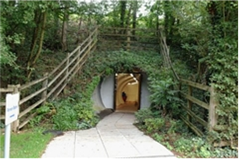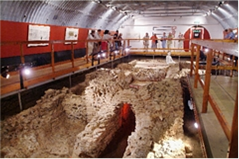Tunnel through time to the world of the Romans – with a visit to Welwyn Roman Baths.
You can’t take a hot bath any more – the boiler went out about 1,800 years ago when the Romans left! But you can see some fascinating remains which have survived from their time. The Welwyn Roman Baths are a Roman ruin preserved under the A1(M) just north of modern-day Welwyn Garden City. The baths were a small part of the Dicket Mead villa, which was originally built in the 3rd century AD.
Learn about how the Romans liked to relax with an elegant culture of bathing, and admire their creativity and style. The bath house  remains are a scheduled ancient monument and were once part of the fine villa. The layout of the cold, warm and hot rooms and the heating system are remarkably well preserved.
remains are a scheduled ancient monument and were once part of the fine villa. The layout of the cold, warm and hot rooms and the heating system are remarkably well preserved.
The baths are ingeniously protected in a steel vault under the A1(M) motorway. You can find out how this vault was built during your visit. Once the vault was completed the motorway was built over the top of it, and the remains of the baths sit 9 metres below junction 6. Only about half of the original extent of the baths is now on display. Visible parts remaining include the hypocaust, the tepidarium (warm room), caldarium (hot room) and the frigidarium (cold room) floor and cold bath, constructed from opus signinum (made of tiles broken up into very small pieces, mixed with mortar, and then beaten down with a rammer).
Also on display are archaeological finds from the Welwyn area and an exhibition devoted to the history of the site, which was uncovered during the 1960s and 70s by the Welwyn Archaeological Society. The full extent of the Dicket Mead villa was never fully excavated prior to the construction of the motorway, and the baths were only one of at least four buildings in total. The complex was probably part of a farm. It has b een speculated that it might have been at least in part the equivalent of a hotel, lying as it does near Roman roads.














